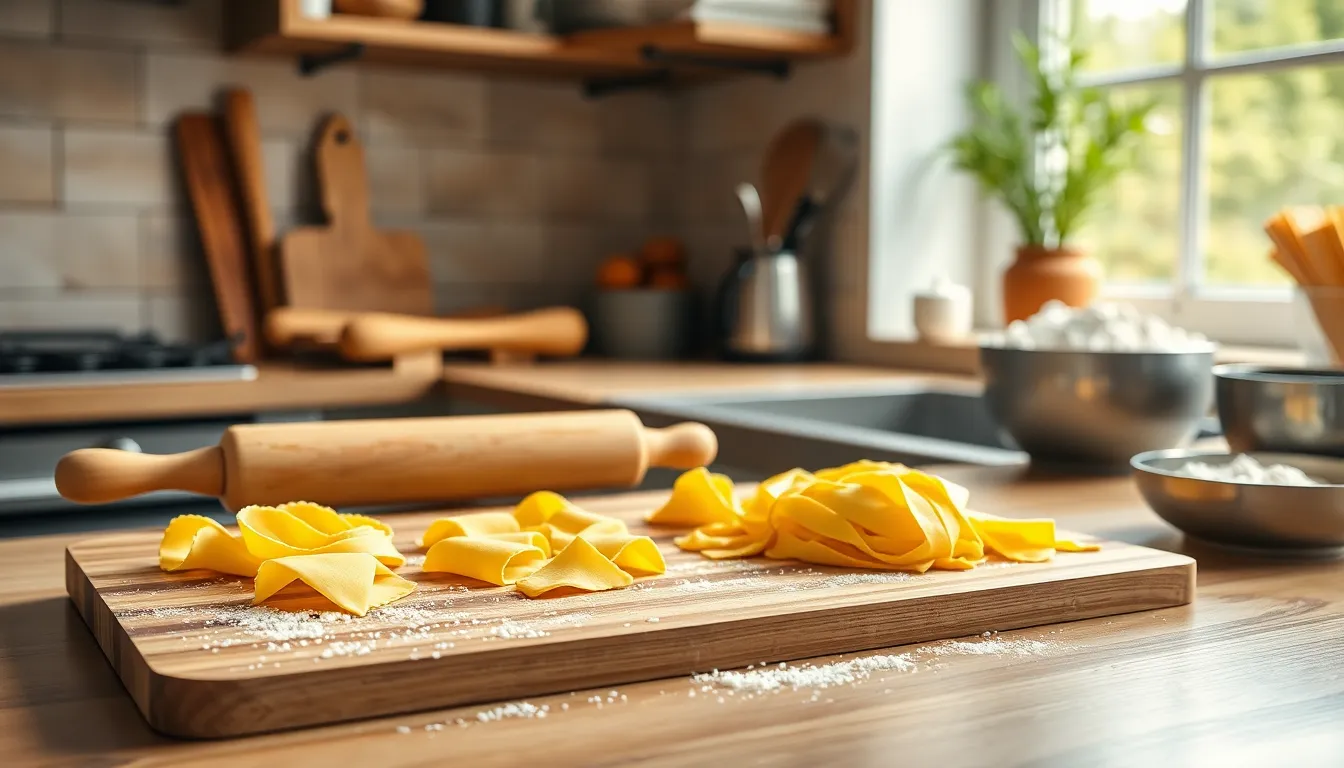Imagine twirling forkfuls of fresh, homemade pasta that practically dances off the plate. It’s not just a meal; it’s a culinary experience that’ll make even your grandma jealous. Making pasta from scratch might sound daunting, but it’s easier than finding a parking spot in a crowded lot. With just a few simple ingredients and a sprinkle of love, anyone can whip up a batch that’s tastier than anything from a box.
Table of Contents
ToggleWhat Is Homemade Pasta?
Homemade pasta refers to pasta made from scratch using simple ingredients, typically flour and eggs. This culinary product differs significantly from factory-made options, offering fresher flavors and a unique texture. Delicate and customizable, it allows cooks to create various shapes and sizes, such as fettuccine, ravioli, or tagliatelle.
Making homemade pasta involves a straightforward process. First, mixing flour and eggs creates a dough. Upon kneading the dough, it becomes smooth and elastic, a sign that it is ready for rolling. Afterward, the rolled sheets can be cut into desired shapes.
Nutritional benefits also accompany homemade pasta. It often contains fewer preservatives than store-bought versions and offers more control over ingredients. Whole grain flours or organic ingredients can easily be incorporated, enhancing health benefits.
Enjoying homemade pasta builds a deeper connection to cooking. Families can gather around the table to assist with production, transforming a meal into a bonding experience. Serving homemade pasta showcases creativity and effort, impressing guests at dinner parties.
Accessibility further defines homemade pasta. Cooks don’t require specialized equipment; a rolling pin and a sharp knife suffice for many recipes. Specific pasta machines can speed up the process, yet they remain optional.
Ultimately, making pasta at home opens the door to endless culinary opportunities. Through experimentation, individuals can explore their taste preferences while mastering a beloved staple of Italian cuisine.
Benefits of Making Homemade Pasta

Making pasta from scratch offers numerous advantages that elevate the culinary experience. The benefits range from enhanced flavor to healthier ingredient options.
Authentic Flavor
Freshly made pasta delivers a taste that factory-produced varieties can’t match. It’s crafted using minimal ingredients, allowing the natural flavors to shine through. Each bite reveals a unique texture and depth, enhancing the overall dining experience. The simplicity of the ingredients promotes a rich, authentic flavor profile. Herbs and spices can be easily incorporated into the dough, adding personalized touches that store-bought pasta lacks.
Creative Control
Homemade pasta provides unlimited opportunities for creativity. Different shapes, sizes, and flavors can be explored, from traditional fettuccine to innovative stuffed varieties. Adjusting thickness and texture becomes easy, allowing for customization to suit individual preferences. Unique blends of flour, such as semolina or whole wheat, can be used alongside various fillings to create distinct pastas. This culinary freedom transforms a simple meal into an artistic endeavor.
Healthier Ingredients
Selecting wholesome ingredients is another key benefit of making pasta at home. Home cooks can use organic eggs and high-quality flours, avoiding preservatives common in mass-produced options. Nutritional content can be tailored by incorporating whole grain flours or alternative ingredients, such as spinach or beetroot, for added flavor and nutrition. Controlling portion sizes contributes to mindful eating habits, making homemade pasta a healthier choice.
Essential Ingredients for Homemade Pasta
Creating homemade pasta requires a few key ingredients that form the foundation of a delicious dish. These essential elements contribute to the flavor, texture, and overall quality of the pasta.
Flour Types
Flour choices significantly affect the texture and taste of homemade pasta. All-purpose flour works well for those just starting, providing a balanced structure. Semolina flour, a coarser option, lends a slightly nutty flavor and a firmer texture, making it ideal for traditional Italian pasta. High-protein flours such as ‘00’ flour offer a silky finish that cooks beautifully. Experimenting with gluten-free alternatives like chickpea or almond flour gives flexibility for different dietary needs.
Eggs vs. Water
Eggs play a crucial role in enriching the pasta, imparting flavor and providing a tender, silky dough. Commonly, two eggs per cup of flour create a rich consistency. Alternatively, water can be used for a lighter version, allowing for the addition of various ingredients. Choosing between eggs and water depends on the desired richness and the type of pasta being produced.
Flavor Additions
Enhancing pasta with additional flavors is simple and rewarding. Fresh herbs like basil, parsley or spinach can be blended into the dough for a vibrant touch. Incorporating spices, such as garlic powder or black pepper, elevates the overall taste. Creative options include adding beet or squid ink for color and unique flavor profiles. Personalizing pasta with these additions leads to exciting culinary experiences.
Techniques for Making Homemade Pasta
Creating homemade pasta involves a few key techniques that ensure delicious results every time. Mastering the processes of mixing, kneading, rolling, and shaping significantly enhances the pasta-making experience.
Mixing and Kneading
Start by placing flour on a clean surface, forming a well in the center. Crack the required eggs directly into the well. Gradually mix the flour into the eggs using a fork, incorporating flour from the edges. Once the mixture becomes too stiff to mix with a fork, use hands to form a cohesive dough. Knead the dough for about 8-10 minutes until it feels smooth and elastic. Resting the dough for at least 30 minutes allows the gluten to relax, which makes it easier to roll out later. This initial mixing and kneading phase sets a solid foundation for achieving the perfect texture.
Rolling and Shaping
Use a rolling pin or pasta machine to flatten the rested dough. First, cut the dough into manageable pieces. Rolling it out to about 1/16 inch thick offers the best result for most pasta types. Adjust the thickness according to personal preference and specific pasta shapes. Cut the rolled-out dough into desired shapes like tagliatelle or lasagna sheets. To form stuffed pasta, like ravioli, place filling on one sheet, then cover it with another sheet. Press around the filling to seal, ensuring no air pockets remain. Proper rolling and shaping techniques result in consistent shapes, improving cooking quality.
Cooking and Serving Homemade Pasta
Cooking homemade pasta requires attention to timing for optimal texture and flavor. Typically, fresh pasta cooks quickly, often within 2 to 4 minutes. Ensure a large pot of salted water is boiling before adding the pasta. Larger shapes like tagliatelle may take slightly longer, while delicate items like tortellini require less time. Always test a piece before draining to confirm it’s cooked to al dente perfection.
Cooking Times
Cooking times differ based on pasta thickness and shape. Freshly made sheets often cook in 2 to 4 minutes, while thicker varieties can take up to 6 minutes. Test by tasting a piece to achieve that firm bite without being undercooked. Dried pasta, in contrast, usually takes 8 to 12 minutes, depending on the specific brand and shape. Monitoring water temperature also influences cooking dynamics.
Pairing Sauces
Pairing sauces with homemade pasta enhances the dish’s appeal. Lighter sauces like olive oil and garlic complement delicate shapes. For pasta with more robust flavors, consider heavier sauces like meat ragu or cream-based sauces. Fresh herbs and grated cheese elevate the overall taste. Creamy sauces cling well to shapes like fettuccine, while chunky sauces suit shapes like penne. Season sauces with salt and pepper to balance flavors, ensuring each bite is satisfying.
Homemade pasta transforms a simple meal into a memorable culinary experience. With just a few basic ingredients and some creativity, anyone can craft delicious pasta that outshines store-bought options. The process not only fosters creativity but also encourages family bonding in the kitchen.
By experimenting with different flavors and shapes, home cooks can personalize their dishes to suit any palate. The health benefits of using fresh ingredients further enhance the appeal of homemade pasta. Embracing this culinary adventure allows for a deeper appreciation of Italian cuisine while delivering a dish that’s both satisfying and wholesome. It’s time to roll up those sleeves and dive into the art of pasta making.



